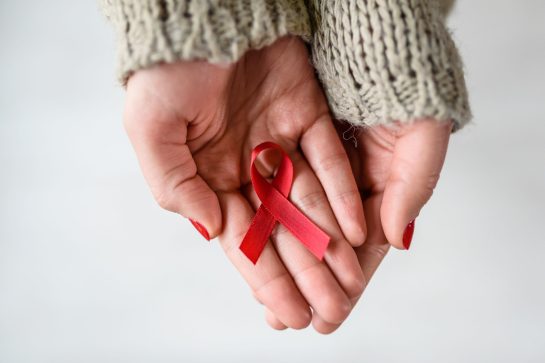HIV/AIDS impacts more than solely gay men. In fact, 23 percent of cases in the United States occur in women. How can social-service organizations better support these populations? It starts with understanding the unique needs of women in HIV/AIDS care.
HIV and Women’s Health
Did you know 1.2 million Americans currently live with HIV? Of that population, about 13 percent—or 156,000 individuals—don’t even know they are infected. Despite decades of new research, treatments, and advocacy, HIV/AIDS still remains a public health crisis in the United States.
Not all populations have the same risk of contracting HIV/AIDS. While ethnic minorities and men who have sex with men are more likely than others to contract the disease, they are not the only populations at risk. In fact, nearly 1 of 5 infections occurs in women. HIV awareness and treatment is a critical part of women’s health but does not always get the focus it requires.
To get a better picture of HIV and women’s health, consider the following breakdown of female HIV cases:
- The majority of HIV infections in women occurs between ages 25 and 44.
- Women in ethnic-minority groups experience increased risk of HIV.
- Black women account for more than half of all female diagnoses.
- Infections in women come primarily from heterosexual contact (~85%) or injection drug use (~15%).
- 14% of transgender women are diagnosed with HIV. The stigma that transgender women experience in healthcare often acts as an additional barrier for them to receive care.
- Any woman who is sexually active and/or injects drugs is at risk of HIV/AIDS.
Clearly, HIV/AIDS is a critical issue for women’s health. Health and human-service organizations can help push back against this public health crisis, but understanding the current situation is only the first step.
PrEP and HIV Prevention
Although HIV still does not have a cure, researchers and medical professionals have made critical strides in preventing infection and extending both length and quality of life for those living with the disease.
The most common form of prevention is known as pre-exposure prophylaxis, or PrEP. PrEP is a once-daily pill that has proven success in preventing HIV infection even with direct exposure, meaning that PrEP is the key to keeping at-risk populations negative. Although this medication is readily available in all 50 states, only about 25% of eligible people are currently taking PrEP.
When considering gender differences for PrEP use, the gap is even greater. Men are almost 3 times as likely to take PrEP as women, with only 10% of women receiving care. When considering how women make up 23% of all HIV cases, this disparity becomes even more concerning.
There are several possible explanations for this gender gap. PrEP is often advertised as a medication strictly for LGBTQ+ men, even though it is just as effective for women. Social-service organizations can benefit from initiatives focused on raising awareness for PrEP use among women.
Treatment for HIV-Positive Women
Despite increased efforts to prevent HIV infections, thousands of Americans are still diagnosed with the life-changing disease every year. For instance, in 2018, healthcare professionals diagnosed over 7,200 women with HIV. What treatments are available for the women in this category?
PEP, or post-exposure prophylaxis, is a daily medication for those living with HIV. It has shown to drastically improve both length and quality of life for HIV-positive individuals and can even prevent positive individuals from infecting others. In February 2022, there was one reported incident of an HIV patient appearing to be cured with stem-cell treatment.
The Role of Social Services and HIV/AIDS
Unfortunately, both PrEP and PEP treatments require utilizing the current medical system. For those who rely on social services, this barrier can be monumental. Both medications require consistent, daily use. When individuals fall through the cracks of social services, it can directly interrupt their HIV prevention and treatment plans.
However, when social-service organizations utilize coordinated care to keep track of those they serve, they can become a powerful tool for women’s health. Central to this idea is a secure case-management system like ClientTrack. Case-management platforms are designed to keep track of HIV care for every person that health and human-service organizations serve, eliminating some of the biggest barriers facing HIV/AIDS reduction.
Even if your social service organization does not directly provide HIV care, it is critical that your team knows about the risks of HIV as well as available community resources. Here are some ways your health and human service organization can get started:
- Identify current HIV/AIDS resources in your community
- Include HIV risk screening in your intake assessments
- Focus on raising awareness of HIV prevention and treatment, particularly for women
- Coordinate care with other HHS organizations to prevent attrition
Women Living with HIV
The road to mitigating HIV/AIDS in women (and in all populations) may be long, but it is worthwhile. The more social-service organizations raise awareness and address the unique challenges of HIV in women’s health, the sooner our communities can effectively protect vulnerable people.
If your organization is ready to implement HIV/AIDS tools into your programs, we’re here to help. Our team of HHS experts are ready to help you maximize your organization’s efforts to make sure you can do what you do best: help those you serve. Click here to reach out to our team today.
For more ideas on how to raise awareness for National Women and Girls HIV/AIDS Awareness Day, check out these resources from the US Department of Health and Human Services.



